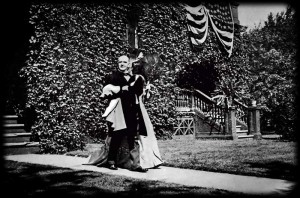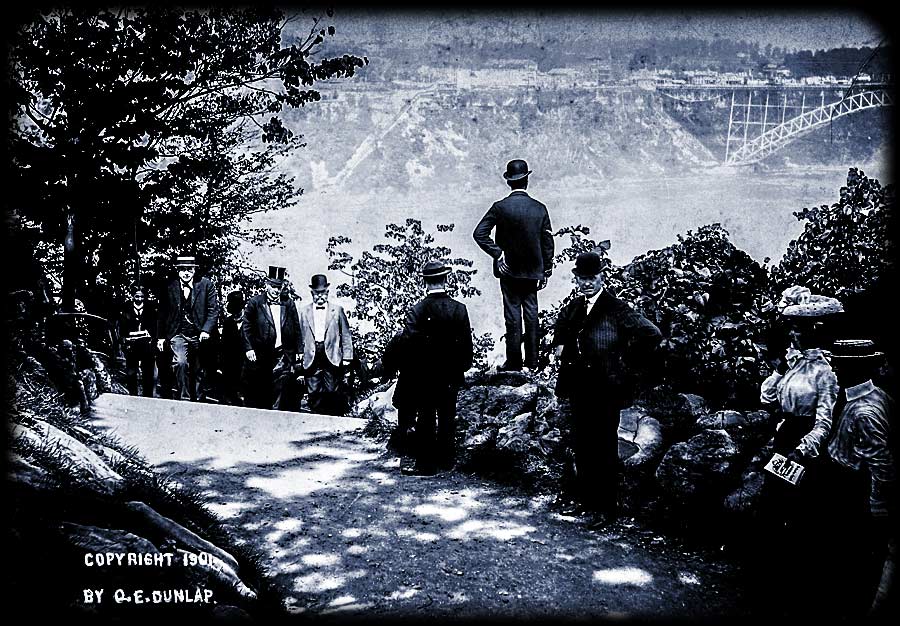This was going to be a good day for the president as he dressed himself in his bedroom at the Milburn house. The had not yet risen, but he could see the sky brightening to the east that it should be great day weather-wise. Ida was still taking her time rising, but she could see her beloved husband was already dressed. As he turned to her as he always had throughout their marriage, he brought his hand up to his lips and casually tossed her a good-bye kiss. “Be back soon,” he whispered.
The rest of the household including his security detail had not yet taken their positions. This was the time of day that William enjoyed the most. He could stroll down the walk and hardly see a soul. It was just him the beauty of the day wrapping itself around him.

Across town Leon Czolgosz was also finishing up dressing. He straightened his string tie, then slipped into his suit jacket. The room’s small mirror didn’t allow him to get a full length view of himself, but it was big enough for him to straighten his hair before tucking a white handkerchief neatly into the jacket’s pocket. He glanced over at the dresser at the new 32 caliber revolver lying there. He and that pistol had already come twice within a stone’s throw of the president.
After his walk around the upper-class neighborhood, McKinley returned to the Milburn house. Ida was up and cooking breakfast for the two. The smell of a fresh pot of coffee drifted through the house. Today they were just going to have a healthy portion of omelets dressed up with a little cheese and some fried potatoes. They were going to have a big luncheon at Niagara Falls later that morning.
Leon didn’t have breakfast this morning when he left the hotel. He did buy a new cigar. The paper had said the president would be leaving this morning sharply at 9:00 a.m. by train so he could see the new power plant at Niagara Falls, and of course the falls.
He and Ida walked down the Milburn sidewalk to their waiting carriage. There was already a large crowd gathered, a reporter snapped a photo of the couple. By the time their carriage reached to the waiting train it had already passed by Leon as he too made his way to the station. Leon followed the president to Niagara, but after spending a little time there, he decided he would never get close as close as he thought he needed to be. Leon returned to Buffalo. He would wait for the president to come to him.

The president viewed the American and Horseshoe Falls from the Upper Steel Arch Bridge, then visited Prospect Park and Goat Island. They then went to the International Hotel for a luncheon and then took a carriage drive to the power house for a complete tour of the electrical machinery and dynamos. It was all very exciting for the president and he immensely enjoyed every moment. By mid afternoon it was time to leave.

The Pan American Exposition architectural theme was called the Free Renaissance style, which just meant that the architects designing the exhibits should make sure they incorporated elements from European buildings popular a few centuries ago. The Temple of Music was a spectacular building that served as the concert hall for the Pan American Exposition. It cost more than $85,000 which would almost $2 million in today’s dollars. The Temple of Music could be called the epitome of Free Renaissance style.
It’s ornate style overwhelmed the eye; its symmetry screamed Renaissance and at night all of its architectural features were emphasized with electric light bulbs. Each afternoon 2,000 people would fill the great domed auditorium to listen to the largest pipe organ ever built in the United States. The sounds of that organ would vibrate clear through body (the organ is now in a Catholic church in Buffalo).
After returning from Niagara, the president went straight to the Temple of Music while Ida went back to Milburn house to rest. The reception at would be the crowning event where visitors to the exposition could actually shake hands with the most popular president in recent memory. Earlier that day in local papers there was a brief news item from Copenhagen that said Emperor Nicholas of Russia would have loved to visited Paris, but his security detail persuaded by “fears of an Anarchist outrage” convinced the Emperor not to make the trip.
In Buffalo there was no such warning announced in the paper, but President McKinley’s secretary, George Cortelyou had strongly suggested he not to do the Temple of Music reception. In fact the secretary had taken this event off the schedule twice, and both times McKinley personally put it back.
Anarchists as they were called, had decided that capitalism and the authority powered through capitalism could only be controlled through violence. Violence was the only way of giving the power to the people. In a few years, the Anarchists would be replaced after the overthrow of the Russian Emperor Nicholas by the Bolsheviks, a modified form of the Anarchists.
Leon Czolgosz was an Anarchist. He had studied in great detail previous assassinations and murders. He was well educated in the Anarchist methods and reasons, and he knew that on this day in September, he would join his brethren in making America a better place for the working man.
The line had beginning to form outside the Temple of Music since lunch. Among those at the head of the line was Fred Nieman. Later people standing in line with Fred said he had no interest in making small talk, or even complain about the extraordinary hot day they were experiencing.
Fred Nieman was the name Leon Czolgosz used when the hotel manager questioned him after he signed John Doe to the registry. Later that day when police began their questioning, he would use the name Fred Nieman. It wouldn’t be till later that his real name became known.
Very close to 4:00 p.m. word began spreading through the visitor line that someone had seen the president’s carriage. In fact, the president had arrived, and he was escorted in through another entrance where he quickly took his designated place. McKinley gave the go ahead for the procession to begin.
Leon Czolgosz was not first in line, but he was near the front, with maybe 10 or so in front of him. As they got closer, the security increased, but no one said anything about Leon’s right hand perpetually tucked in his coat pocket. Security was watching the man in line just in front of Leon. They would later say that he had the look of an Anarchist and when he wouldn’t let go of the president’s hand, security became even more alarmed and forced the man to move. It was a tense moment and all the security detail must have felt relief when the Italian looking immigrant moved on. No one seemed concerned about the small framed, neatly dressed man next in line.
Leon had gone through all the mutations of how to approach the president, how to cover his hand that was holding the pistol. How to ignore the handkerchief wrapped around his hand if it caught fire from the first gun shot. Squeeze the trigger once, twice and maybe three times and then run.
Leon got off two shots as he looked at the large man in front of him eye-to-eye before anyone understood what had just happened. The president stepped quickly stepped backward as a result of the gun flash and the loud retort.
A large black man standing behind Leon saw the muzzle flash and reacted almost instantly by striking Leon in the back of the neck with one hand and simultaneously grabbing his gun hand to prevent another shot from being fired.. Then a crowd of security and well-wishers descended upon Leon. In just moments Leon was being pummeled by fists.

The president had stepped back with his arm across his chest holding on to his waist coat and could see the melee in front of him. “Don’t let them hurt him,” he shouted loudly.
Along side the president was Secretary Cortelyou, John Milburn, and Detective Geary. Not yet realizing the full impact of what had just happened, they stood motionless. They urged the president to sit down, but he told them to just remain calm. No need to alarm the public any more than they already were. “But sir, you’re wounded,” Cortelyou said. “No, I think not,” said the president. “I’m not badly hurt…” Nevertheless they managed to get him seated. Only upon pulling back his outer layer of clothing did they see the spreading blood stain.
Seeing the look on their faces, McKinley calmly said to Secretary Cortelyou about telling Ida, “Be careful Cortelyou… how you tell her… oh, be careful.”
Leon was quickly ushered out of the hall and into a side room. From here he was taken to the Buffalo police station where he was questioned. Police were convinced Leon had help and they were determined to find those individuals as quickly as possible. They could not be certain how deep this plot went or who the next target would be. Security for Vice President Roosevelt were immediately wired to take extra precautions.
The president was taken by an electric ambulance to the the Exposition hospital. However, the only personnel on duty were some nurses and interns. They did begin advanced first aid on the president. Meanwhile word went out to find a qualified doctor.
McKinley had two wounds: one was a minor wound to his right chest caused by a ricocheting bullet. The other wound was to his abdomen. McKinley had found the ricocheting bullet in his clothing during the brief ambulance ride. The other bullet was still lodged inside. The examination room was not suited for surgery, but none the less the doctor and nurses tried to find and extract the second bullet. They first gave the president a morphine injection. Then an extensive exploration for the second bullet was conducted. They could not find that bullet and after determining there was no internal bleeding, they stitched up the president and the president was driven back to the Milburn house which now had armed guards protecting it.
The president would rest comfortably at Milburn house for the next several days. Doctors would come and examine him and ask how he felt. Occasionally, the president would receive additional morphine injections.
For the next week the president would gradually improve until the September 13, and then everything changed dramatically.